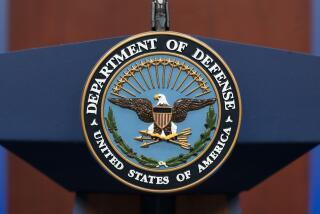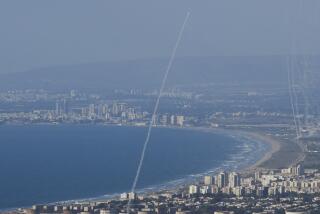U.S. Fighters Place Faith in Weapons
ABOARD THE USS ABRAHAM LINCOLN IN THE PERSIAN GULF â It may be hard to imagine deadly weapons as a source of comfort, but those charged with firing todayâs âsmartâ bombs say their accuracy eases the psychological burden of unleashing force that could kill innocents as well as the enemy.
âWe all have wives and kids we worry about and I worry about people with wives and kids in Iraq, too,â said Cmdr. Scott Swift, deputy chief of the air wing aboard this nuclear-powered carrier, a key launch pad if war with Iraq comes. âItâs disturbing for everybody, but particularly for those individuals who have to pull the trigger, for those called upon to execute the nationâs will.
âThereâs a lot of concern about collateral damage, about civilians being involved,â said Swift, whose 2,400-plus aviators and support crew would deliver warâs punch. âBut the weapons are now precise enough that if there are no civilians placed at military targets, there will be no civilian casualties.â
To take out the same number of military targets hit during the 1991 Persian Gulf War, Swift estimates that U.S. forces will be able to use half as many bombs and missiles, thus halving the risk of strikes going awry.
âThe difference this time is going to be the number of smart bombs we use,â said Lt. Paul Dosen, the carrierâs weapons assembly officer and a 1991 Gulf War veteran. âThat means the collateral damage is going to be a lot less, and thatâs something weâre very concerned about. We build these bombs of destruction and we want to know they are hitting the right targets.â
The 320 Lincoln crew members responsible for storing and arming the weapons loaded onto the air wingâs 70 fighter aircraft do so with the sobering knowledge that their behind-the-scenes combat role is just as much a life-or-death matter as it is for the pilots who deliver the strikes.
After seven months away from their own families, the added stress of an expected engagement is taking an emotional toll, Dosen said.
âEverybody needs to know about the sacrifice going on here,â the 24-year Navy veteran said of his crewmates, who were turned around to the Middle East in December, halfway home to Everett, Wash. âThere are divorces happening now. Thatâs the sad part of it. The morale of the crew is phenomenal. Sailors always rise to the occasion. But itâs always hard, especially for the families.â
Part of that psychological weight has been eased by the technological breakthroughs in weapons design, say Lincoln sailors and fliers.
Each aircraft carrier group is escorted by cruisers and destroyers, all armed with Tomahawk cruise missiles with a 1,000-mile range. The fighter aircraft on board carry smart bombs outfitted with GPS targeting systems allowing strikes accurate within a few feet. Laser-guided âbunker bustersâ can burrow deep below the Earthâs surface to destroy underground threats, and âglide bombsâ can be programmed to circle a target and approach from any angle.
The predominance of precision-guided munitions to be used in any forthcoming battle means reduced risk for aviators, said Cmdr. Jeff Penfield, leader of the F/A-18E Super Hornet squadron that will be conducting the aircraftâs first combat operations if the current face-off evolves into war.
âThe weapons are so precise now that I can send one weapon per aim point and hit four targets with one plane,â he said. âIf you can send one airplane to do what it used to take four airplanes to do, you donât need to put as many people into harmâs way.â
Lt. Roy Ferreira, a tactical action officer from Placentia, Calif., who has the authority to approve the firing of on-board weapons, notes that state-of-the-art Tomahawk cruise missiles aboard each carrier groupâs escorting cruisers and destroyers give the Navy strike capability without putting U.S. aviators at risk of return fire.
Like most of those preparing the expected offensive, Ferreira believes that the U.S. and coalition forces have an overwhelming advantage because Iraq has been able to maintain little more than crude antiaircraft batteries and radar.
âI donât think the war will be nearly as long as people think,â he said, describing coalition air and naval power as beyond comparison with anything Iraq could have, with one considerable caveat. âThe biggest threat is on the asymmetrical side, that they could use chemical or biological weapons.â
No one minimizes the risks of an Iraqi attack with nerve gas or smallpox, but those patrolling the âno-flyâ zones over Iraq for the last dozen years say Baghdad has limited capacity to deliver those hazards.
At most, say pilots familiar with residual Iraqi munitions, biological or chemical agents could be launched at coalition ground forces with imprecise, unguided short- or medium-range projectiles.
Tempering confidence with caution, those managing the massive prewar buildup draw strength from their formidable arsenal.
âSuffice it to say that in any type of warfare scenario that involves aircraft carriers, we are certainly capable of bringing air power to the problem and using it very effectively,â said Capt. Philip Greene, commander of the destroyer squadron accompanying the Lincoln.
*
(BEGIN TEXT OF INFOBOX)
Military facts
The U.S. military, preparing for a possible war with Iraq, said Wednesday that it had activated more than 16,000 additional Reserve troops. The following forces are in or near the Middle East and could be used in any U.S.-led attack on Iraq.
U.S. Navy
6 aircraft carriers -- five American and one British -- are within striking distance of Iraq, including the Kitty Hawk, Abraham Lincoln and Constellation, which are in or near the gulf.
Carriers typically deploy about 75 planes, including about 50 attack aircraft. Each warship is shepherded by about half a dozen cruisers, destroyers and submarines with long-range Tomahawk cruise missiles.
1 hospital ship, Comfort, is in the region.
U.S. personnel
175,000 U.S. ground, naval and air troops are in the gulf region near Iraq -- including nearly 100,000 Army soldiers and Marines in Kuwait. The U.S. total could reach 230,000 by mid-March.
168,083 Reserve and National Guard troops on active duty, which include those called up this week.
Central Command
More than 1,000 U.S. communications personnel and several hundred British counterparts staff the mobile âCentComâ post in Qatar, the headquarters of Gen. Tommy Franks, who would direct any war on Iraq.
Air bases
Several radar-evading F-117A stealth fighters are exercising at Al Udeid Air Base in Qatar. The Air Force has sent B-1B bombers, F-15C fighters, F-15E attack jets, F-16 fighters, A-10 attack jets, Predator unmanned spy planes and radar aircraft.
Turkeyâs parliament has given permission to upgrade an unspecified number of Turkish military bases. U.S. aircraft based there would join 200 other jets based in Kuwait, Bahrain, Qatar, Oman, Djibouti and Saudi Arabia.
Source: Reuters
Los Angeles Times
More to Read
Sign up for Essential California
The most important California stories and recommendations in your inbox every morning.
You may occasionally receive promotional content from the Los Angeles Times.











